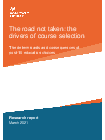Research and analysis: The road not taken: drivers of course selection

The Social Mobility Commission investigated the drivers of socio-economic differences in post-16 course choices and their likely social mobility consequences.
Documents
The road not taken: drivers of course selection
PDF, 1.13MB, 75 pages
This file may not be suitable for users of assistive technology.
Request an accessible format.
If you use assistive technology (such as a screen reader) and need aversion of this document in a more accessible format, please email [email protected].Please tell us what format you need. It will help us if you say what assistive technology you use.
The road not taken – review of literature and survey evidence
PDF, 535KB, 25 pages
This file may not be suitable for users of assistive technology.
Request an accessible format.
If you use assistive technology (such as a screen reader) and need aversion of this document in a more accessible format, please email [email protected].Please tell us what format you need. It will help us if you say what assistive technology you use.
Details
It’s more important than ever to consider how students from all backgrounds can access high-quality academic and technical education, due to the severe disruption to their schooling and the level of economic shock experienced during the pandemic.
A crucial point to consider is what happens when young people reach the age of 16. This is when students make decisions about their education and choose what type of course to follow, as well as the level and subjects that they would like to study. These choices are pivotal as they can strongly influence their future educational opportunities, employment prospects and even how much they will go on to earn.
This report uses a mixed-methods approach to investigate the socio-economic differences in post-16 choices, factors driving these differences and the likely social mobility consequences of picking the most popular options. The report has achieved this by using administrative data linking the education and earnings of young people who took post-16 qualifications in the mid-2000s.
In addition, to better understand the key behaviours driving the choices, the authors undertook in-depth interviews with senior leaders, curriculum managers, teachers and learners from five learning providers. This has been supplemented by a review of relevant literature and survey evidence.
Published 30 March 2021












Responses